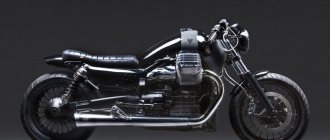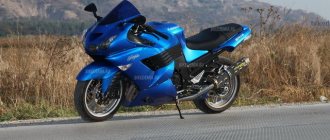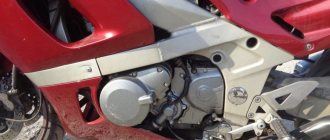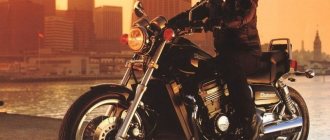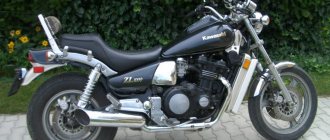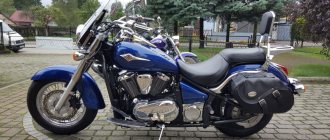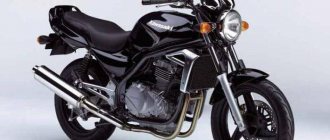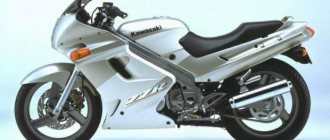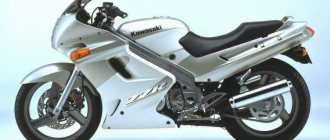1400GTR (CONCOURS 14)
- motorcycle model, Kawasaki brand,
The Kawasaki 1400 GTR sports touring motorcycle model began its production in 2007 (before it, the Kawasaki GTR 1000 model was produced). The Kawasaki ZX-14 (ZZR1400) hyperbike platform was taken as the basis, combined with advanced technologies used in modern flagship sports tourers. On the US market, this model was called Kawasaki Concours 14.
The Kawasaki 1400 GTR features an inline 4-cylinder liquid-cooled engine that produces 160 hp. (with inertial supercharging) and 136 Nm of torque. The motor is tuned for traction in low and medium operating ranges, and has a variable timing system (from Mitsubishi Motors). Maximum engine performance is achieved at 6000-9000 rpm.
Another important feature of the motorcycle is the Tetra-Lever multi-link rear suspension, much like BMW (Paralever) and Moto Guzzi (CARC). When braking and driving over uneven surfaces, the rear of the motorcycle does not rise, but remains under load all the time, which has a positive effect on handling.
Among other things, the model is equipped with the KIPASS (Intelligent Proximity Activation Start System) system, which means access to starting the motorcycle without a key. The essence of the system is that the ignition key is always inserted into the lock, but it can only be turned if the owner of the motorcycle is standing nearby.
Other features of the Kawasaki 1400 GTR include a slipper clutch, electrically adjustable windshield, integrated saddlebags, tire pressure monitoring system, combined braking system (with ABS), aluminum frame, fully adjustable sports suspension, traction control (KTRC), heating steering handles and cardan drive.
Model history
2007 - official start of production and sales of the Kawasaki 1400 GTR model.
2010 - The Kawasaki 1400 GTR motorcycle underwent a major update - engine traction control (KTRC), combined braking system (with ABS), new bodywork (which improved engine cooling), new mirrors (40 mm higher), adjustable windshield glass with a memory function, a fuel saving system (it controlled the ratio of gasoline and air at low revs and speeds) and heated grips. Top speed was limited to 247 km/h.
2011-2014 – only the color schemes of the motorcycle and its individual elements changed.
2015 - The motorcycle undergoes minor changes regarding gearbox ratios, upgraded steering (to improve stability at low speeds), increased rear suspension stiffness, added windshield opening adjustment, reprogramming of the ABS unit and a number of minor cosmetic changes - silver instrument bezels panels, extended heat shields on the exhaust pipes, changing the color of the warning lamp from red to yellow, changing the shape of the seat, adding a new color Candy Lime Green, etc.
Blog
Traveling to overseas countries, we sometimes forget that all the best is nearby. Russia is the only country in the world where you can find such a variety of natural landscapes, the beauty of which is due to their inaccessibility and non-intervention of humans in wild nature. Travelers on Kawasaki GTR 1400 motorcycles from different cities of Russia traveled thousands of kilometers to see the deepest and cleanest lake in the world - Baikal.
The first day was not easy. The start was planned for 9 am, but while everyone was gathered, we finally left at almost 12. For the first hundred kilometers we got used to each other’s pace and collected fallen things from poorly secured bags.
Fortunately, everyone is moving in the same mode, no one is slowing down. 140-160-180 – depending on road conditions. Almost all of them have the same fuel consumption, 5-6 liters per 100 km. First repair: the number fell off. The mount for the license plate broke; it turned out to be too flimsy for our roads. They tied it with clamps.
The road was paved through Rezh, Irbit, Tyumen - there are no traffic jams, no traffic police, no trucks, minimal cars. The roads are better than on the Tyumen highway. After Tyumen the asphalt is even better. To Ishim. After Ishim, the road is being repaired and a large number of trucks have accumulated on the highway. Overtaking can be difficult.
Omsk Novosibirsk We drove more than a thousand km in a day. Now I can already say that this section of the road to Lake Baikal is the most difficult for me. Constant overtaking is very exhausting.
I really liked the city of Novosibirsk. Large, wide and smooth roads. We couldn’t fall asleep until 4 am with joy. We woke up at 11 o’clock and went to balance the wheel on the FJR1300 (on the road it turned out that the wheel starts to vibrate after 140 km)).
We fixed the problem, now Ilya can “water” with us, otherwise we had to constantly wait for him! As a farewell photo, we took a photo with the jippers and trophy raiders who sheltered us in their garage! Julia, Stas - thank you.
We drove only 600 km from Novosib. And we spent the night somewhere 300 km before Krasnoyarsk. We passed the city of Kemerovo - the capital of Kuzbass. Hereditary miners mine coal here.
The roads, starting from Novosibirsk, are of excellent quality! In some places, of course, there are uneven areas, but in general you can unscrew the throttle all the way. Moreover, after Novosibirsk there were much fewer trucks, and in general the flow of cars decreased greatly and the roads became more interesting.
In the evening we stopped at a village to swim in the Kia River.
Day four.
We drove 1025 km. Starting from Kemerovo to Krasnoyarsk, the sky was clouded with dense haze. This is the taiga burning... There is no smell of burning, but visibility is poor.
We didn’t stop by Krasnoyarsk, because... Because of the smoke, we still wouldn’t have seen anything. On the way back we will stop at the famous hydroelectric power station. We passed the city of Kansk, where one of our motorcycle tourists served.
The navigator showed us to drive through the city, but we decided that it would be faster to take the bypass. And we ended up on a 7 km dirt road! So, when you are in these places, drive directly through the city, without turning left at the “Irkutsk” sign.
After Kansk, closer to Irkutsk, road repairs begin. A total of 30 km of dirt road. We spent the night in Tulun at the Central Hotel, which was very good, by the way.
Day five. In a godforsaken village.
In Irkutsk itself the roads are bad. Doing exercises 
On the way out of the city we met a group of Hungarians. They traveled through Mongolia and are now heading home to Europe. We were very surprised that we were going to Olkhon as sports tourists. They warned us that 40 km of clay awaited us before reaching Khuzhir.
To cross to Olkhon Island, you need to drive through several sections of unpaved road, and then board a ferry. The ferry is free. But the queues for the ferry are huge. Not for bikers - motorcycles without a queue. Motorists get very nervous when they see us driving around a traffic jam, and sometimes they jam. But seeing this, the ferrymen waved their hand, saying, let us pass, and we entered the ferry at special places for motorcycles.
Here we are just before the start of the road to the ferry crossing.
I think the road repairs will be completed in the next few years. But now you will have to endure a few kilometers.
Our safety is also threatened by gophers and bitumen.
Here comes the ferry.
After disembarking the motorcycles, we paid an environmental fee of 60 rubles per person - voluntary. And we headed towards Khuzhir, the main village of Olkhon Island. 35 kilometers of gravel road! This road is very treacherous after rain, because... consists of clay and sand. In some places the motorcycle begins to “float”. In addition, the constant ripples on the road are very tiring; if you drive slowly, it shakes, if you drive quickly, it doesn’t shake, but driving into the mud at high speed risks falling. Luckily, we successfully completed the 35 km without falling. Although we have heard plenty of stories about flying on this road.
But what are the roads when our reward is the most amazing lake in the world - Baikal!
Photos cannot convey this grandeur and open spaces, nature and smells of the Baikal shores. Baikal is endless, like the sea! 700 kilometers long is a whole day's drive in one direction! And the nature here is like nothing else.
Olkhon is a huge island on a huge lake. It is almost always sunny here and rarely rains. The climate on Olkhon is special and different from the entire coastline on the mainland. You immediately feel the smells of the sea, pine trees, and meadow grass. And the mountains darken around, on the other side.
In front of Khuzhir we were met by the 5th participant of our motorcycle expedition, Ilyas, who started to Baikal earlier than us. He took care of our accommodation, so we quickly settled down, gave him a free T-shirt, took photos and went to dinner with Baikal delicacies.
Only on Lake Baikal is there omul, a very tasty fish, which is served here in any form, fried, smoked, in fish soup, dried. I personally really liked the hot smoked one; it is prepared all along the coast, right along the highway. It is especially tasty when it has not yet cooled down. It’s a pity that it’s almost impossible to bring it home, it spoils quickly.
The next day we signed up for a “sea trip”. Our boats.
Tourists are landing.
Fishermen on the pier collect their catch.
There were two Krasnoyarsk bikers with us on the boat. The rest of the tourists were shocked...
The excursion included a visit to an island with a Buddhist stupa and a landing on the mainland, where some springs were located, and also a lunch of fish soup. We were not interested in the sources, because... there was a small cafe on the shore with beer on tap, which was the best source for most. The cafe also served delicious pancakes and poses (like dumplings). In general, we decided to stay on the shore, swim, eat poses and omul. All the tourists, fortunately, went 2 hours up the mountain to these springs, and no one bothered us to rest.
Excursions on Olkhon are divided into sea, car and horseback tours. That is, you can be delivered to the same place both by sea and by land. The most beautiful place on Olkhon, according to most tourists, is Cape Khoboy in the north of the island. An excursion by sea costs 1800 rubles, and by land 600. We had an excursion for 1500 to the springs. Horses are only carried for short distances. Within walking distance, in the village itself, there is another attraction of the island - the Shaman Stone. There is no entertainment on Lake Baikal yet, other than what nature offers. It's for the better.
The next morning they repaired the FJR, the oil seal leaked, everything was successfully repaired.
Housing on Olkhon is not inferior in price to European prices. 400 rubles – a bed in a barn house. A room with a toilet and washbasin for two cost us 2,700 rubles. I'm afraid to even guess how much a normal room costs.
Therefore, it is best to live on Olkhon in tents. There are plenty of free places from tourists. And for now it's free. We took some firewood and went to look for a parking spot.
We don't take easy roads.
We rolled around the GTR for a bit. Sliders rule.
As a result, we found the best place - with a view of the Shaman Stone, mountains and Lake Baikal! We spent several unforgettable days here...
Then everyone began to go home. Some to Moscow, some to Surgut, some to Yekaterinburg. Only we (Sasha and I) decided to go further, towards Ula-Ude, to see the other shore of Lake Baikal, Buryatia and Ivolginsky Datsan.
Baikal saw us off with dazzlingly sunny weather, bright blue skies and fluffy white clouds.
Farewell photo.
Part 2.
After our sports-tourist group went home, we moved further to the east, with the goal of driving around Baikal as far as the asphalt allowed. After Irkutsk, the landscape changes greatly compared to the northern part of the lake. The route turns into a narrow, steep serpentine road. The trucks can’t get away from this road, and they travel at a speed of 30-40 km per hour. Therefore, “overtaking is prohibited” signs are completely ignored by cars. By the way, in the rest of the Irkutsk region the situation is similar. You can never be sure that some driver will not fly out of the turn towards you.
Not far from Ulan-Ude (10-15 km) is the largest Buddhist temple in Russia - the Ivolginsky Datsan. Moreover, this is not one building, but a whole complex - a mini-village, with various buildings (a library, residential buildings, stupas, a museum, a mini-zoo and even a nursery for Tibetan wolfhounds!). We arrived in Buryatia, coincidentally, on the main holiday of the year, when the parishioners were supposed to be shown the Russian Lama. Therefore, all hotels near Datsan were booked several days in advance. But we are again lucky to have good people; a kind Buddhist grandfather met us at the entrance to the datsan and found us a room for the night. In general, it is surprising that the person who saw us for the first time was so happy and sincerely glad to meet us.
On the territory of the datsan there is an enclosure with fallow deer (it seems). In the temple you can buy bread (2 rubles) and feed them. We bought all the bread we had 
In the evening, an expedition from China arrived at the datsan, moving along the “Great Tea Route”
60 new jeeps. And not the cheapest ones. In addition to SUVs and SUVs, there were also cars! I don’t understand how they walked through the Gobi Desert?! They were accompanied by our Russian guys in a UAZ. They told us a lot of funny stories. It turns out that this is not just an expedition of enthusiastic people, as we are accustomed to. And this is a party of Chinese “oligarchs”. Almost everyone travels with drivers. None of them know how to service cars, and they are all used to living in 5-star hotels, which is why difficult situations arose during the trip... They told us a funny story about the fact that when one of the Kruzaks needed to change the tire, the Chinese got it instructions for use and began to study it carefully. In general, the guys were emotional and shocked by everything that was happening. Buryat police officers stood nearby, who were supposed to accompany this entire column on their section of the road. They say that they are passing the Chinese from hand to hand. And the column came here to meet the lama. But only 20 people were allowed to see the lama, and the proud Chinese were offended and refused such an offer. By the way, the Chinese in every possible way deny that they are oppressing the lama in Tibet, everyone knows, I think, what this confrontation led to there.
We gave our guys a sticker, and they gave us their own aircraft helicopter plant.
Then the guys from Vladivostok arrived. They walked with the “Wave of Memory”, and now they were moving towards Olkhon.
Both on dragstars, 400 and 1100 cc, with girls!
We exchanged phone numbers with them, we were sure that we would see each other again!
In the morning we took a souvenir photo near the entrance to the temple complex and drove back, already towards Altai. Impressions from Datsan remained extremely positive.
The Buryat side of Lake Baikal is very different from the Irkutsk side. It immediately feels like we are in the taiga. Even the climate here seemed harsher to me; there was a chill blowing from Lake Baikal. And then it started to rain. We drove all day to Kultuk at a temperature of 8-10 degrees.
We took shelter from the rain in a decent hotel on the shore of Lake Baikal. We were going to meet the Vladivostok guys in Arshan - a place that everyone unanimously advised us to visit. But the rain and cold made their own adjustments. We texted them that a warm shower and a soft bed were waiting for them! And after a few hours, soaked to the skin motorcycle travelers shared their impressions of the weather. The next day we did not go to Arshan again due to the weather. We put on our raincoats and hurried to leave for sunny Novosibirsk, where at that moment it was 34 degrees, judging by the news reports.
Closer to night, we stopped at a motel, where we met a Swede driving a BMW K1600GT, who was driving to Lake Baikal. He still has all the dead roads ahead... When asked, how is the motorcycle? He answered - very expensive)) He says that he goes for 80-90 maximum. Strange Swede... They assured him that there were no police here, you could go safely. He widened his eyes - how can this be? Why did he need 1600 cubic meters then, he also could not answer. He had more things with him than the two of us, and he took off all the trunks at night and took them with him to the hotel. And in the trunks he had porridge, cookies, sugar, milk mixtures, cans of tea and coffee. Apparently he thought that there was nothing to eat in Russia. Recently he texted that he had reached Baikal and was already in Moscow. It’s a pity that I didn’t stop by Ekaterinburg.
In Krasnoyarsk the weather has improved significantly. We stopped by to see local attractions - the Krasnoyarsk hydroelectric power station (the one on the 10-ruble bill) and the Astafievskaya Tsar Fish, which is life-size.
Yenisei
Hydroelectric power station.
Having driven 100 km from Krasnoyarsk, we decided to return, because... Our tires suddenly ran out. The stock tires on the GTR1400 Bridgestone are complete crap and last for a maximum of 10 thousand kilometers. Whereas Michelin keeps almost 20. The problem was that when we called the Novosibirsk stores, nothing was found except a Korean tavern. Fortunately, there was a Continental in Krasnoyarsk.
I would like to thank the Krasnoyarsk bikers for their troubles in finding tires, as well as the Motoden company for installing them.
We washed the motorcycle and went to meet the locals.
In Krasnoyarsk, bikers gather in 2 places, plastic at the Opera House, and plumbing and other labor bikers on the embankment. I’m exaggerating, of course, but they definitely have some kind of division. From the road I saw motorcycles on the embankment, so we went there first. We were lucky again, Zhenya took us under his wing on a Harley. He gave us a night tour of the city accompanied by other Krasnoyarsk motorcyclists, sheltered our motorcycle, and the next day took us to the famous Stolby nature reserve. If it were not for Zhenya, we would have learned much less about Krasnoyarsk, and the impressions would not have been so complete.
State Nature Reserve "Stolby". Here you need to buy a pass.
Memorial plaques to those who died here, crashing against the rocks.
The reserve has been landscaped, even a staircase has been built to the first pillar.
The pillars are similar to our Devil's Settlement, only much larger.
I would have liked to stay here longer, but time was running out. We said goodbye to Zhenya and invited him to Yekaterinburg. Much respect to him for the hospitality shown. It was really nice to meet a nice person.
After 2 days we were already in Altai. Along the way, we stopped by the village of Srostki, where Vasily Shukshin was born and spent his childhood. It is a pity that in the school curriculum his works were marked only for home study, and few of my peers read them. Although, in my opinion, his stories are much more interesting than most of the tedious stuff I had to read in school.
In general, there is nothing so interesting in the village. But from Mount Piket, where the monument to the writer is erected, there is a beautiful view.
Altai has recently been divided into two parts: the Altai Republic and the Altai Territory. This is related to national-ethnic issues. Mountain Altai and all the beautiful places are located in the republic.
The roads here are beautiful, good, but narrow.
As soon as the Katun River appears within sight, the tourist area immediately begins. Up to Ust-Sema, all the villages are just hotels and restaurants. We arrived and realized that this was not what we needed... It felt like we were in Gelendzhik. So we decided to avoid the tourist area.
Seminsky Pass is the highest point of the Chuysky tract.
The main attraction of the Altai Mountains, in my opinion, is the Chuisky tract itself, which runs through the entire Altai right up to the border with Mongolia.
We stayed in an excellent quiet place, the eco-village “AiL.
Landslides threaten road surfaces.
Such an unusual monument was recently built on the Chuysky tract.
Don't buy...
The glacier appears unexpectedly
Many people ride motorcycles to the glacier itself, or rather to its foot. But we were so tired of driving through the Baikal off-road that we limited ourselves to just admiring it remotely.
We drove up one of the hills to see the panorama. It was more difficult to go back down, because... The road consists of a sand track. The motorcycle actively helped us with all its ABS and traction control. By the way, the last thing is very useful under such road conditions, the wheel does not slip and does not skid. I wish they could start installing this option on all modern motorcycles as soon as possible.
After the glacier, there is only a picturesque road to Mongolia. But we decided not to go to Mongolia
Mountain Altai is no less beautiful place than Baikal. But more accessible. But it seemed to me that both Baikal and Altai need to be ridden on light enduro bikes, 250-400 cc. How the locals do it. Then you can see the coolest places, drive through Lake Baikal along the wild northern shores or around Olkhon, visit a glacier or the Ukok plateau in Altai. Novosibirsk residents bring motorcycles to Altai on a trailer and drive them on mountainous off-roads inaccessible to cars and even ATVs. And on sports and even touring-enduro (like a goose) you can’t go where these small-capacity cars are passing. So, we'll have to come back here...
I recommend living in close proximity to the glacier in the comfortable hotel “Like Home” at 787 km of the tract. https://www.turistka.ru/altai/info.php?ob=1168. This hotel was one of the first built in the Altai Mountains and the guest book is filled with numerous positive reviews from foreigners on motorcycles. Who was there? It’s hard to imagine that back in the early 00s there were Europeans here who were traveling to Vladivostok, through Mongolia. Near the hotel there is a beautiful forest, a swimming pond, and a picnic area.
Deer sausages. So-so, to be honest...
A 10-minute drive from this hotel is another interesting place accessible to our tires, the red gate.
And a dead lake with cold water.
The road home started with rain!
But we met bikers from Tomsk. We took some photos. The trailer is valid.
That's all. The rest of the journey passed without incident along roads covered in smoke from burning forests. We drove without the sun, because... it was obscured by smoke. Does anyone in our country even monitor the conservation of forest resources?
